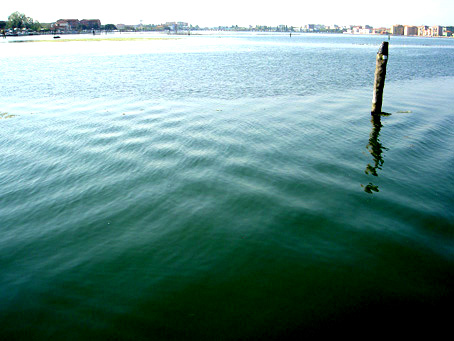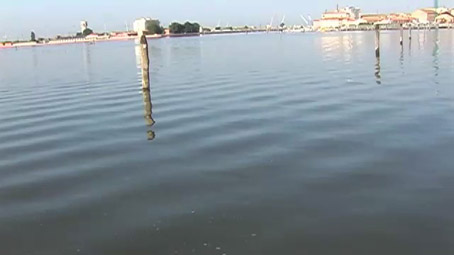2.4.8 - Differences between ordinary waves and variable density water waves.
===========================================================
© copyright notice ||| français ||| italiano
prologue > index tides > 2.4 The cumulative dissipative cycle in water.
2.4.1 The cumulative dissipative cycle in water.
2.4.2 The test Z takes shape.
2.4.3 A natural astronomical observatory for the tides.
2.4.4 The test Z: amplifying a hidden phenomenon.
2.4.5 The water figures.
2.4.6 Density waves.
2.4.7 Other significant cases.
>2.4.8 Ordinary waves and density waves.
2.4.9 For a man-made astronomical observatory for the tides.
===========================================================
Water figures can vary their density in both directions, in close alternating times. They can then be mistaken with ordinary waves, those generated by a mechanical force, acting from the outside (wind, passage of a vessel).
Both ordinary waves and density waves give the impression that they are moving.
However, while in ordinary waves, water molecules have some movement, in those of density, individual water molecules do not move; their motion is completely apparent.
Impression of movement.
The impression of movement would be given by the increase and decrease of water densities (decrease and increase in volume), in short alternating sequences, for more or less regular sectors.
My interpretation is that water would be subject to a short cumulative dissipative cycle, in which its density now increases (cumulative phase), then immediately decreases (dissipative phase). Which should take place following changes in the molecular configurations, alternating in short sequence, now to one direction, then to the other.
The matter is far from defined. I await the checks and contributions of others on this phenomenon.
Perceived as waves.
These figures, if viewed directly, in their context, are perceived as belonging to the "waves" category, implying that they are caused, for example, by the wind, or by the passage of a boat.
From that moment, everything that does not agree with this opinion, is censored by our mind, until our mind itself will accept the "water waves of variable density", as a phenomenon of another nature.
Establish the differences between ordinary waves and density waves.
In this comparison, density waves are not considered when the ordinary ones make them indistinct.
To date, seven features have already been identified in density waves compared to those of ordinary waves. This places the density waves in a separate category.
Considered eight points.
In the first seven appendices, I give peculiar features of the density water waves.
The annex extra presents the phenomenon of interference between ordinary waves and density waves.
feature #1 - Different causes. The ordinary waves and the variable density water waves have different causes. Ordinary ones are caused by a mechanical force (wind, passage of vessel). Variable density waves show the cumulative-dissipative cycle as it unfolds.
feature #2 - Impression of movement. In variable density water waves, the water is stationary. It is the variation of its density, in close alternating times, that gives the sensation of motion.
feature #3 - Limits. The waves due to the passage of a boat can invade areas of shallow water, and even overflow on the shore. This does not happen with variable density waves, for the simple reason that water molecules do not move. The phenomenon can manifest itself only where water depth is enough to allow the necessary heat exchanges.
From the photo below, it can be deduced to some extent where the water level does not have the depth necessary for the manifestation of the phenomenon.

feature #4 - The distance between the crests of a long series of density waves does not vary, thus giving rise to a regular grid, within an well defined area. That does not apply to the ordinary waves.

feature #5 - changing direction. Variable density water waves can be perceived as advancing to one direction, sometimes changing it, every now and then. And even perceived as advancing to two opposite directions, at the same time.
feature #6 - changing velocity and volume. The velocity of a density waves may be perceived to change; for instance it may slow down in a way that it would be impossible for an ordinary wave. Moreover, also it may change its volume, without an apparent cause.
feature #7 - The surface water which is going to be affected by the passage of a wave caused by a boat does not show any harbinger; while, just before a series of density water waves is going to take shape, on that same area, a large bulge may come into view.
annex extra - Waves caused by the passage of an outboard may trigger, immediately afterwards, density waves, with all the features of the latter.